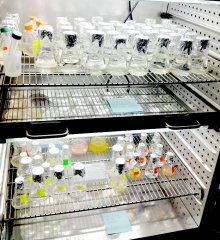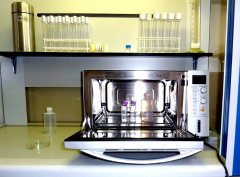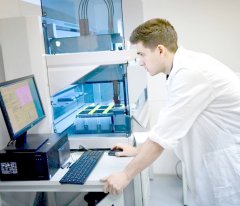
The Resource Collection “Marine Biobank”, Core Shared Research Facility, was organized in 2017 on the basis of the National Scientific Center of Marine Biology (NSCMB), Far Eastern Branch, Russian Academy of Sciences (FEB RAS).
The goal of the RC “Marine Biobank” is to provide scientific research with available collections and equipment in accordance with international protocols for collecting, cataloging, maintaining, and storing biological specimens of marine organisms.
The major fields of the current research activities are as follows:
- Life sciences
- Biomedical and veterinary technologies
- Cellular technologies
- Technologies for monitoring and forecasting the condition of the environment, preventing and eliminating its pollution
- Rational nature management
The RC “Marine Biobank” was formed on the basis of laboratories and the Museum of the NSCMB FEB RAS; in 2017, the “Marine Biobank” fund numbers 106,600 items and comprises the collections of living marine microorganisms and the Museum’s depository collections (“Mollusca”, “Vermes”, “Pisces”, “Cnidaria”, “Ostracoda”, “Arthropoda”, “Meiobenthos”, “Zooplankton”, “Algae and Aquatic Plants”, “Echinodermata”, “Porifera”, and “Bryozoa”). The Museum’s collections are mainly represented by littoral, shelf, and deep-sea samples from the Far Eastern seas of Russia. In addition, a significant portion of specimens were collected from coastal waters of Vietnam and other regions of the World Ocean. Currently, paratypes and holotypes of more than 300 species of marine organisms from different taxonomic groups of animals and plants are deposited in the museum. In recent years, the collection has been regularly expanded with specimens that are used in the “DNA-barcoding of Living Organisms” international program. This project involves the subsequent integration into the global DNA barcodes database (Barcode of Life Data System, BOLD).
The total collection of living marine microorganisms comprises three collections: marine filamentous fungi, marine microorganisms, and marine microalgae, including phycotoxin producers. The collection is registered in the Consolidated Catalogue of Microbial Cultures (http://www.vkm.ru/Cosolidated.htm) and on the website “Genetic and Biological (Zoological and Botanical) Collections of the Russian Federation” under the following numbers: No. 34 (Collection of Marine Microalgae Cultures), No. 35 (Collection of Marine Microorganisms), and No. 36 (Collection of Marine Filamentous Fungi)
http://www.sevin.ru/collections/microcoll/coll_list/coll31.html.
The uniqueness of the collection of marine microbiota consists in
(1) the original (obtained in Russia) clones, isolated by researchers of the institute from the coastal waters of the Far Eastern seas;
(2) the collection contains producers of phycomotoxins, as well as potentially dangerous organisms that cause “harmful bloom of water”.
The collection of obligatory and facultative marine micromycetes includes fungi associated with commercial species of bivalve mollusks, as well as fungi which are potential subjects of bioinvasions introduced into the Far Eastern region of Russia with ballast waters of ships. Since 2016, the collection has been expanded with strains of filamentous fungi isolated from deep-sea habitats (3000–4000 m) and gas-hydrothermal fields of the Sea of Okhotsk. The collection of heterotrophic bacteria has been composed during 15 years from various objects of the marine environment in Peter the Great Bay (Sea of Japan) and Nha Trang Bay (Vietnam). Any re-isolation of these strains is hardly probable, which indicates their uniqueness.
The integrity of the collections is ensured by the use of nitrogen cryo-depositories and other specialized equipment, which provide more than 10 different preservation modes, the original conservation methods known and developed by NSCMB experts, as well as thanks to the long-term experience on their use accumulated by several generations of researchers.
The unique technical, scientific, and methodological capacities of the RC “Marine Biobank”, the professional experience and reputation of the NSCMB staff in the country and on the international level, and also the close cooperation of the NSCMB experts with leading researchers of Russia and other countries are the guarantee that the data obtained as a result of the scientific research will be significant and highly demanded by the scientific community.












